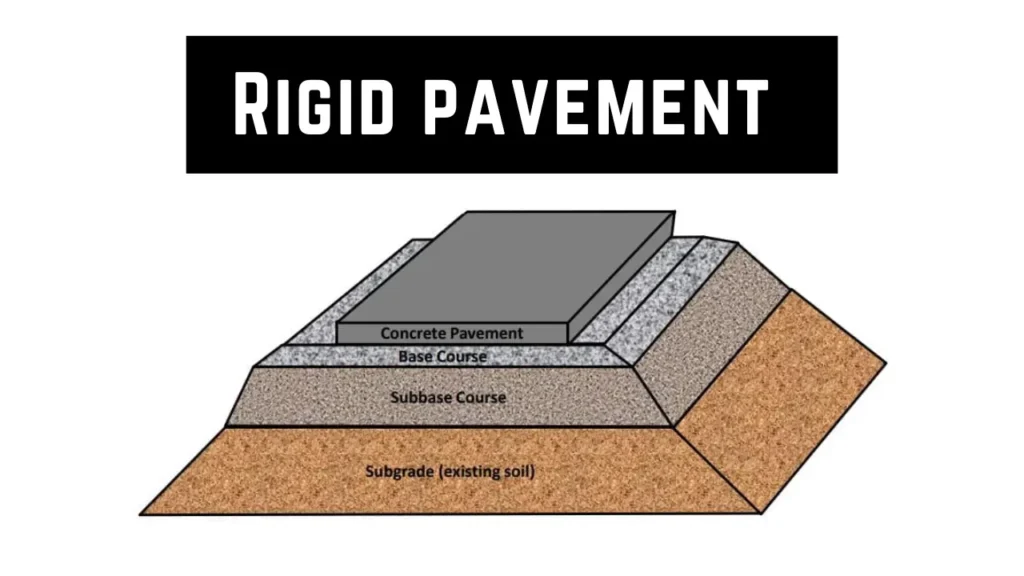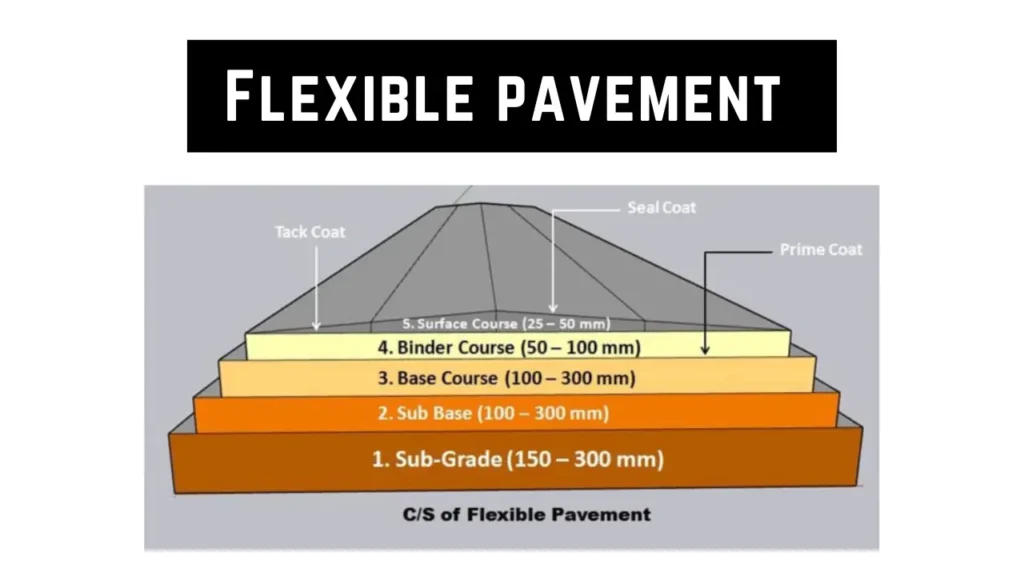Table of Contents
🚧 Rigid Pavement vs Flexible Pavement 🚧
| Features | 🛣️ Rigid Pavement | 🛤️ Flexible Pavement |
|---|---|---|
| 💪 Durability | Long-lasting, handles heavy loads | Suitable for lighter loads, can deform under heavy traffic |
| 🏗️ Material | Concrete slabs | Asphalt layers |
| ⏳ Maintenance | Requires less frequent maintenance | Requires more frequent maintenance |
| 🌡️ Temperature Sensitivity | Less affected by temperature changes | Can soften in hot temperatures |
| 💰 Cost | Higher initial cost, cost-effective over time | Lower initial cost, higher maintenance costs |
Rigid Pavement

- Definition: R pavements are made of concrete, which provides with a high level of stiffness and for the even distribution loads across a wide area. This rigidity reduces deformation when to heavy loads.
- Materials Used: The primary material these pavements is cement concrete, which is often with steel to effectively tensile stresses.
- Surface Layer: uppermost layer is concrete slab. Base Course :Below the slab lies a base course, can consist of aggregates a stabilized sub-base support the concrete structure. Subgrade: The foundational layer located beneath the pavement is essential for the integrity of the entire structure.
- Load Distribution: Thanks to the concrete’s high stiffness, rigid pavements distribute loads effectively, minimizing deformation of the subgrade.
- Lifespan: Built for resilience, rigid pavements typically last 20-30 years or longer with little maintenance.
- Applications: These types of ements are suitable for high-traffic areas such as highways, airport runways, and major urban roads where long-lasting performance is necessary.
Advantages Rigid Pavement
- Durable with minimal upkeep.
- Capable of supporting heavy traffic volumes.
- Performs Dependable in various weather conditions.
Disadvantages Rigid Pavement
- Higher initial construction expenses.
- Takes longer to cure before becoming operational.
- Repairs can be more complicated and costly.
Flexible Pavement

- Definition: Flexible pavements are composed of several layers that can bend and deform under loads, enabling them to distribute weight effectively over a broader area.
- Materials Used: The predominant material for flexible pavements is asphalt, combined with various aggregate layers.
Structure
Surface Layer: The top layer is made from asphalt. Binder Course: This layer helps bond the surface to the base course using bituminous material.
Base Course: A layer of crushed stone or gravel offers support and assists in load distribution.
Sub-base Course: Situated underneath the base course, this layer provides additional support.
Subgrade: The foundational layer supporting the entire pavement structure.
4. Load Distribution: Flexible pavements manage loads through multiple layers, primarily deforming in the subgrade and base layers.
5. Lifespan: Typically, flexible pavements last around 10-15 years, requiring regular maintenance to extend their service life.
6. Applications: These pavements are often found in areas with lighter traffic, such as residential streets and rural roads.
Advantages Structure
- Lower initial costs for construction.
- Quicker construction time and faster usability.
- Simpler and more affordable repairs.
Disadvantages Structure
Materials: Rigid pavements consist of concrete, while flexible pavements are composed of asphalt.
Load Distribution: Rigid pavements spread loads over a large area, whereas flexible pavements distribute loads through multiple layers.
Cost and Maintenance: Rigid pavements involve higher initial costs but less frequent maintenance, while flexible pavements are less expensive to build but need more routine care.
Lifespan: Rigid pavements usually have a longer lifespan compared to flexible pavements.
This comparison highlights the unique characteristics and uses of both pavement types, assisting in making an informed choice for specific construction projects.
Structure of Rigid and Flexible Pavements
Rigid Pavement Structure
- Surface Layer:
The very top layer of rigid pavements is the concrete slab, commonly made from Portland cement concrete. This layer bears the traffic loads directly and spreads them across a wide area. Its stiffness helps resist significant changes in shape under pressure. - Base Course:
Directly beneath the concrete slab is the base course, which may consist of granular materials such as crushed stone, gravel, or a stabilized base made with cement or asphalt. This layer supports the concrete slab, helping to ensure even load distribution and preventing settling into the subgrade. - Sub-base Course (Optional):
In certain designs, an extra sub-base course may be placed between the base course and the subgrade. Made from compacted gravel or crushed stone, this layer aids in load distribution and offers additional protection against frost and moisture. - Subgrade:
The subgrade is the natural soil layer that serves as the foundation for the entire pavement structure. It is critical that the subgrade is well-compacted and stable to avoid differential settlement, which could lead to cracks in the concrete slab. The rigidity of the slab helps to limit stress transferred to the subgrade.
Flexible Pavement Structure
- Surface Layer:
The top layer in flexible pavements is the asphalt layer (wearing course). This layer comes into direct contact with traffic and is designed to be flexible, allowing it to slightly deform under load, which aids in distributing weight to the underlying layers. - Binder Course:
Below the surface layer, the binder course is made of asphalt mixed with larger aggregates. This layer enhances load-bearing strength and connects the surface layer to the base course, reducing the likelihood of cracking under heavy traffic. - Base Course:
The base course is a thick layer composed of crushed stone, gravel, or other aggregate materials. It transmits the load from the binder course to the sub-base or subgrade while providing necessary structural support. - Sub-base Course:
The sub-base course is located beneath the base course and typically consists of lower-quality aggregates or soil stabilized with cement or lime. This layer provides additional structural support and improves drainage, helping to prevent frost heave. - Subgrade:
The subgrade for flexible pavements is the natural soil layer that underpins the entire structure. It is imperative that the subgrade is compacted and stable, as it bears a significant portion of the load transferred from the layers above.
Key Differences in Structure
Load Distribution: Rigid pavements rely on the concrete slab to spread loads across a large area, reducing stress on the subgrade. Conversely, flexible pavements depend on multiple layers to distribute loads, with the subgrade carrying a notable share of the load.
Material Layers: Rigid pavements generally have fewer layers (concrete slab and base course), while flexible pavements consist of several layers, including the surface, binder, base, and sub-base courses.
Flexibility vs. Rigidity: Rigid pavements are designed to remain stiff and resist bending, thus efficiently distributing loads. In contrast, flexible pavements are constructed to flex and bend under loads, assisting in the load distribution through their various layers.

Hello! I’m Vaishnavi, a civil engineer who enjoys sharing how we design and build structures. My blog makes understanding engineering easy and interesting for everyone!


Hi, I’m Jack. Your website has become my go-to destination for expert advice and knowledge. Keep up the fantastic work!
Reading The post was like going on a first date with my mind. Excited for the next rendezvous.